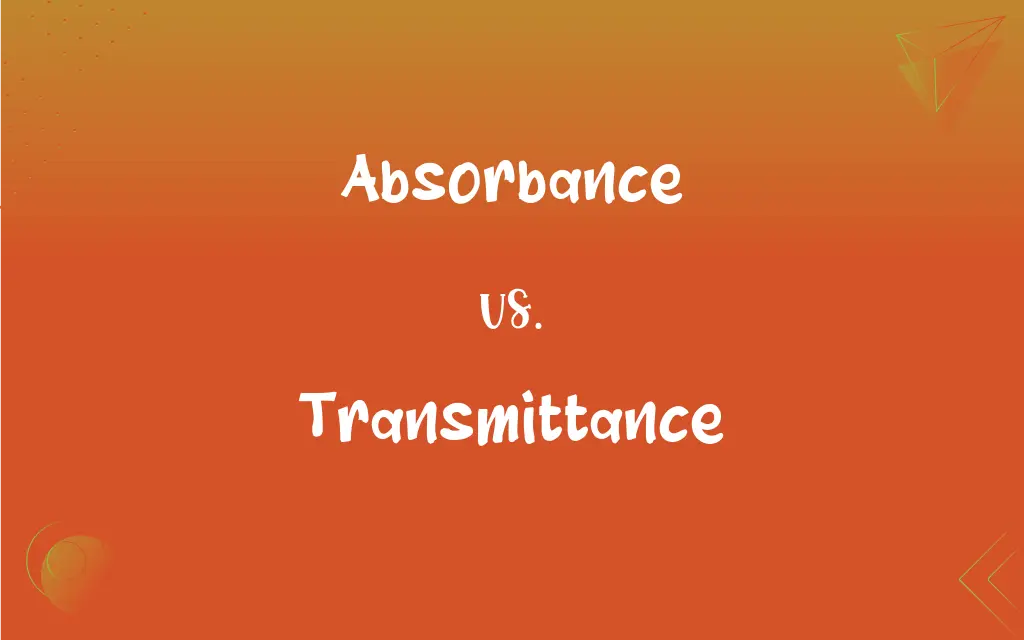Absorbance vs. Transmittance: What's the Difference?
Edited by Aimie Carlson || By Harlon Moss || Updated on October 4, 2023
Absorbance measures how much light a substance absorbs, while transmittance measures how much light passes through.

Key Differences
Absorbance quantifies the amount of light absorbed by a substance when light passes through it. In contrast, transmittance indicates the fraction of incident light that is transmitted through the substance.
High absorbance in a material means it absorbs more light and allows less to pass through. Conversely, high transmittance indicates that the material allows most of the light to pass through and absorbs less.
Absorbance and transmittance are inversely related: as one increases, the other decreases. For instance, if a substance has an absorbance of 1, its transmittance is 10% (logarithmic scale), highlighting the opposite nature of the two parameters.
Instruments like spectrophotometers can measure both absorbance and transmittance. When assessing a sample's absorbance, the device measures the light intensity before and after it passes through, while for transmittance, it gauges the fraction of light that successfully traveled through the sample.
In various scientific fields, especially in chemistry and biology, absorbance aids in determining the concentration of a solute in a solution using Beer's Law. At the same time, transmittance helps to understand the clarity or purity of a substance by gauging how much light it allows to pass through.
ADVERTISEMENT
Comparison Chart
Definition
Amount of light absorbed by a substance
Fraction of light that passes through a substance
Relation
Inversely proportional to transmittance
Inversely proportional to absorbance
Measurement Scale
Typically unitless (logarithmic scale)
Expressed as a percentage or fraction
Higher Values Indicate
More light absorption
More light transmission
Typical Usage
Determining solute concentration in solutions
Assessing clarity or purity of substances
ADVERTISEMENT
Absorbance and Transmittance Definitions
Absorbance
Quantification of light absorption by a material.
The red dye's high absorbance gave the solution its deep color.
Transmittance
Indicates a substance's transparency level.
The high transmittance of the lens ensured clear vision.
Absorbance
An inverse metric to transmittance.
As the sample's absorbance increased, we noticed a proportional decrease in transmittance.
Transmittance
Measurement of light passage through a substance.
The clear water's high transmittance allowed sunlight to reach deep.
Absorbance
Indicates a substance's ability to capture photons.
The plant's leaf showed significant absorbance in the blue and red spectra.
Transmittance
Expressed as a percentage or fraction of incident light.
With 95% transmittance, the glass was nearly transparent.
Absorbance
Measurement contrasting initial and transmitted light intensity.
With an absorbance of 2, very little light made it through the sample.
Transmittance
Inversely related to absorbance.
As the transmittance decreased, the solution's absorbance rose.
Absorbance
Directly related to a substance's concentration in solutions.
The protein solution's absorbance allowed for calculating its concentration.
Transmittance
Assesses a material's clarity or purity.
The crystal's 99% transmittance reflected its exceptional purity.
Absorbance
(physics) A logarithmic measure of the amount of light that is absorbed when passing through a substance; the capacity of a substance to absorb light of a given wavelength; optical density.
Transmittance
A transmission.
Transmittance
(Physics) The ratio of the radiant energy transmitted to the total radiant energy incident on a given body.
Transmittance
A transmission
Transmittance
(physics) the fraction of incident light, or other radiation, that passes through a substance
Transmittance
Transmission.
Transmittance
The fraction of radiant energy that passes through a substance
FAQs
How are absorbance and transmittance used in lab settings?
Absorbance helps determine solute concentrations, while transmittance assesses substance clarity.
Is it accurate to say that a clear substance has low absorbance?
Yes, clear substances typically have low absorbance and high transmittance.
What does absorbance represent in a sample?
Absorbance indicates how much light a sample absorbs.
How is transmittance different from absorbance?
While absorbance measures light absorption, transmittance quantifies the light that passes through a sample.
Can a substance have both high absorbance and high transmittance?
No, they are inversely related; if one is high, the other is typically low.
Are absorbance and transmittance always related to visible light?
No, they can pertain to other electromagnetic radiation types, like UV or infrared.
Is there a mathematical link between absorbance and transmittance?
Yes, A = -log(T), where A is absorbance and T is transmittance.
Why would a scientist want to measure transmittance?
To determine a substance's clarity, purity, or specific properties related to light passage.
Can changes in temperature affect absorbance and transmittance?
Yes, especially if the change affects the sample's molecular structure or concentration.
Can two substances with similar absorbance values have different transmittance?
Theoretically, given the inverse relationship, if absorbance values are similar, transmittance values should be too.
How does a high absorbance affect a substance's appearance?
High absorbance typically makes a substance appear darker due to less transmitted light.
Can two transparent liquids have different transmittance values?
Yes, even if both seem clear, they might transmit different light percentages.
If a sample has an absorbance of 1, what's its transmittance?
It's approximately 10% due to the logarithmic relationship.
Are there limits to absorbance values a substance can have?
Practically, most spectrophotometers read absorbance between 0 and 2, but it can be higher for very concentrated samples.
What instruments measure absorbance and transmittance?
Spectrophotometers are commonly used for such measurements.
How is absorbance connected to Beer's Law?
Beer's Law relates absorbance to solute concentration, path length, and molar absorptivity.
Why is absorbance often unitless?
It's based on a logarithmic scale comparing transmitted and incident light intensities.
How can increasing solute concentration affect absorbance?
Increasing solute concentration typically raises the absorbance value.
Does a 100% transmittance mean a substance has no color?
Not necessarily; it means all incident light passes through, but color can result from selective absorption of certain wavelengths.
If a substance's transmittance is 50%, what does it imply?
It implies half of the incident light passes through, and the other half is absorbed or reflected.
About Author
Written by
Harlon MossHarlon is a seasoned quality moderator and accomplished content writer for Difference Wiki. An alumnus of the prestigious University of California, he earned his degree in Computer Science. Leveraging his academic background, Harlon brings a meticulous and informed perspective to his work, ensuring content accuracy and excellence.
Edited by
Aimie CarlsonAimie Carlson, holding a master's degree in English literature, is a fervent English language enthusiast. She lends her writing talents to Difference Wiki, a prominent website that specializes in comparisons, offering readers insightful analyses that both captivate and inform.






























































